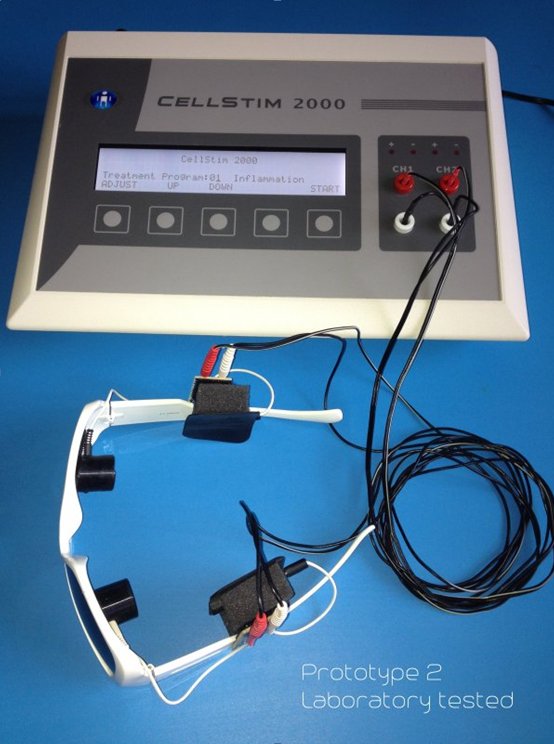iCare-AMD slows down the effects of macular degeneration by applying specific waveforms through patent pending eye wear.
iCare-AMD System Features
- Patient friendly self contained glasses incorporating advanced electronic technology
- Processor controlled specific frequency waveform stimulators for each eye
- Measures and stores time and date stamped patient treatment and compliance data
- Patient non compliance detection automatically communicates to doctor notifying emergency
- Doctor uploads patient treatment data from glasses to server for evaluation of treatment
- Server tracks treatment efficacy and automatically adjusts treatment protocol
- Position adjustable, dry electrode system eliminates the use of self-adhering sticky pads
- Automatic power up when patient wears glasses eliminating the need for a power switch
- Inductively coupled charger and data I/O docking tray
- Increases clinic patient retention by improving the doctor to patient technology interface

References
- Michael L & Allen, M. Nutritional supplementation, electrical stimulation and age related macular degeneration. J of orthomolecular medicine, vol 8, no 3, 1993
- Newsome DA1, swartz M, leone NC, elston RC, miller E. Oral zinc in macular degeneration. Arch ophthalmol. 1988 feb;106(2):192-8.
- Dor h. Beitrage zur electrotherapie der augenkrankheiten. Albrecht von graefe archklin exp ophthalmol 19:352 1873
- Gekeler F, bartz-schmidt K. Electrical stimulation-a therapeutic strategy for retinal and optic nerve disease? Graefes arch clin exp ophthalmol (2012) 250:161-163
- Transcutaneous electrical retinal stimulation therapy for age-related macular degeneration. Shinoda K, imamura Y, matsuda S, seki, M, uchida A, grossman T, tsubota K. The open ophthalmology journal (2008) volume: 2, pages: 132-136
- Anastassiou, G., A.-L. Schneegans, M. Selbach and S. Kremmer. 2013. Transpalpebral electrotherapy for dry age-related macular degeneration (AMD): an exploratory trial. Restorative neurology and neuroscience 31(5): 571-578.
- Neuroprotective effect of transcorneal electrical stimulation on light-induced photoreceptor degeneration. Ni YQ, gan DK, xu HD, xu GZ, da CD. Exp neurol. 2009 oct;219(2):439-52. Doi: 10.1016/j.Expneurol.2009.06.016. Epub 2009 jul 2.
- Axonal regeneration induced by repetitive electrical stimulation of crushed optic nerve in adult rats. Tagami Y, kurimoto T, miyoshi T, morimoto T, sawai H, mimura O. Jpn J ophthalmol. 2009 may;53(3):257-66. Doi: 10.1007/s10384-009-0657-8. Epub 2009 may 31. Department of ophthalmology, hyogo college of medicine, nishinomiya, hyogo, japan.
- Transcorneal electrical stimulation alters morphology and survival of retinal ganglion cells after optic nerve damage. Henrich-noack P, voigt N, prilloff S, fedorov A, sabel BA. Neurosci lett. 2013 may 24;543:1-6. Doi: 10.1016/j.Neulet.2013.03.013. Epub 2013 mar 21.
- Neuroprotective effect of transcorneal electrical stimulation on light-induced photoreceptor degeneration. Ni YQ, gan DK, xu HD, xu GZ, da CD. Exp neurol. 2009 oct;219(2):439-52. Doi: 10.1016/j.Expneurol.2009.06.016. Epub 2009 jul 2.
- Electrical stimulation ameliorates light-induced photoreceptor degeneration in vitro via suppressing the proinflammatory effect of microglia and enhancing the neurotrophic potential of müller cells. Zhou WT, ni YQ, jin ZB, zhang M, wu JH, zhu Y, xu GZ, gan DK. Exp neurol. 2012 dec;238(2):192-208. Doi: 10.1016/j.Expneurol.2012.08.029. Epub 2012 sep 10.
- Gene expression profiling of the retina after transcorneal electrical stimulation in wild-type brown norway rats. Willmann G, schäferhoff K, fischer AMD, arango-gonzalez B, bolz S, naycheva L, röck T, bonin M, bartz-schmidt KU, zrenner E, schatz A, gekeler F. Invest ophthalmol vis sci. 2011 sep 29;52(10):7529-37. Doi: 10.1167/iovs.11-7838.
- Transcorneal electrical stimulation promotes survival of photoreceptors and improves retinal function in rhodopsin p347l transgenic rabbits. Morimoto T, kanda H, kondo M, terasaki H, nishida K, fujikado T. Invest ophthalmol vis sci. 2012 jun 28;53(7):4254-61. Doi: 10.1167/iovs.11-9067.
- Neuroprotective effect of transcorneal electrical stimulation on ischemic damage in the rat retina. Wang X, mo X, li D, wang Y, fang Y, rong X, miao H, shou T. Exp eye res. 2011 nov;93(5):753-60. Doi: 10.1016/j.Exer.2011.09.022. Epub 2011 oct 12.
- Transcorneal stimulation of trigeminal nerve afferents to increase cerebral blood flow in rats with cerebral vasospasm: a noninvasive method to activate the trigeminovascular reflex. Atalay B, bolay H, dalkara T, soylemezoglu F, oge K, ozcan OE. J neurosurg. 2002 nov;97(5):1179-83.
- Effect of transcorneal electrical stimulation in patients with nonarteritic ischemic optic neuropathy or traumatic optic neuropathy. Fujikado T, morimoto T, matsushita K, shimojo H, okawa Y, tano Y. Jpn J ophthalmol. 2006 may-jun;50(3):266-73.
- Transcorneal electrical stimulation improves visual function in eyes with branch retinal artery occlusion. Oono S, kurimoto T, kashimoto R, tagami Y, okamoto N, mimura O. Clin ophthalmol. 2011;5:397-402. Doi: 10.2147/opth.S17751. Epub 2011 mar 23.
- Effects of transcorneal electrical stimulation in patients with stargardt’s disease. [Article in german] röck T, schatz A, naycheva L, gosheva M, pach J, wilhelm B, peters T, bartz-schmidt KU, zrenner E, willmann G, gekeler F. Ophthalmologe. 2013 jan;110(1):68-73. Doi: 10.1007/s00347-012-2749-y.
- Transcorneal electrical stimulation for patients with retinitis pigmentosa: a prospective, randomized, sham-controlled exploratory study. Schatz A, röck T, naycheva L, willmann G, wilhelm B, peters T, bartz-schmidt KU, zrenner E, messias A, gekeler F. Invest ophthalmol vis sci. 2011 jun 23;52(7):4485-96. Doi: 10.1167/iovs.10-6932.
